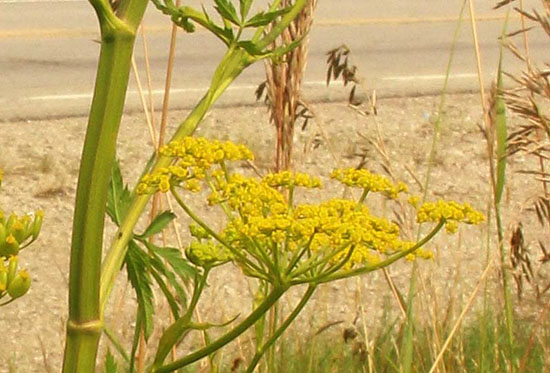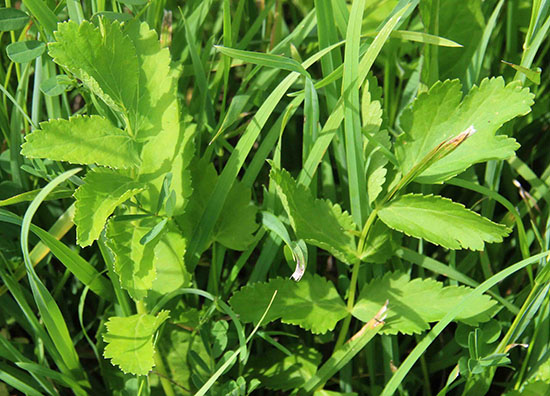Issue 11, July 11, 2016
Wild Parsnip
I love parsnips. Often parsnips (large white carrot-like root vegetable) are substituted for celery in my soups and stews. The cultivated parsnip that we eat heralds from the appropriately named wild parsnip (Pastinaca sativa). Wild parsnip has recently been making the rounds on social media, as the plant can leave individuals with burn-like blisters on their skin. Severe cases appear somewhat gruesome, though according to some, it is still not as bad as the itch of poison ivy.
Standing next to wild parsnip will not give you burning blisters. A person must make skin contact with the sap of the plant from a broken leaf or stem. The combination of sap on your skin and exposure to UV light causes phytophotodermatitis: an interaction between plants (phyto) and light (photo) that induce skin (derm) inflammation (itis) (Ferree 2012). The effects are in effect a severe sunburn.
Wild parsnip is closely related to Queen Anne's lace, and has a similar umbrella-shaped flower, though wild parsnip's flower color is yellow. Wild parsnip's stem is slightly hairy, grooved and 2- to 5-feet tall. Leaves are coarse, with saw-toothed edges (Miller, 2016). Plants can be found throughout Illinois invading prairies, oak savannas, and fens as well as roadsides, old fields, and pastures (WDNR, 2016).

Wild parsnip flower head and square stem.
The actual hazard lies in the sap of wild parsnip, and exposure can be mitigated just by wearing gloves, long pants, and long-sleeved shirts when working outside, in fields or overgrown areas that contain this plant. Plan weeding activities for later in the evening, during low levels of sunlight, to avoid activating the blistering process (Ferree 2012). Wet sap is required to cause injury. Wild parsnip that has been cut and allowed to dry is safer to handle, but seed can develop while the cut plant lays on the ground. Don't wait too long to dispose of cut wild parsnip or forget about them.

Wild parsnip foliage.
Avoid using string trimmers where you may encounter wild parsnip. The pulverizing, flinging action of string trimmers sprays plant parts and juices everywhere. Operators are often left speckled with blisters and red rashes.
If you are exposed to wild parsnip plant sap, wash the area that came in contact immediately. If you are too late and begin to feel the burn of wild parsnip sap, contact your physician for wound care recommendations.
Check sites periodically for the presence of wild parsnip. Just because it isn't there now, doesn't mean it won't germinate next week.
Mechanically control wild parsnip by cutting the root 1- to 2-inches below the soil surface. Brush-cutters can be used for large populations before seed set. For smaller populations, cut off flowering heads and dispose of in a landfill or by burning.
The little rosette of young wild parsnip can be spot treated with herbicides containing the active ingredient 2,4-D, metsulfuron methyl, triclopyr, or glyphosate. Spot treat the large adult plants in May to June with triclopyr or metsulfuron methyl plus a surfactant (WDNR, 2016).

Wild parsnip range map.
Because parsnip is a biennial, all control activities should be done before it starts flowering or at least during early flower stage. The basal rosettes can also be controlled in fall to prevent flowering the next year.
Additional Resources
Illinois Nature Preserves Commission Wild Parsnip Factsheet https://www.dnr.illinois.gov/INPC/documents/vmg/VMG%20Wild%20parsnip%20revised%202007.pdf
Look-a-likes. These plants can be confused for wild parsnip and some have their own nasty maladies http://hyg.ipm.illinois.edu/article.php?id=807
References
Ferree, Rhonda. Parsnips. University of Illinois Extension News Release. June 4, 2012. Updated July 2016. http://web.extension.illinois.edu/fmpt/eb253/entry_11544
Miller, Candice. Plants That Cause Skin Irritation. University of Illinois Extension Handout. https://web.extension.illinois.edu/jsw/downloads/PlantsThatCauseSkinIrritationFactSheet.pdf. Retrieved July 2016.
Wild Parsnip (Pastinaca sativa). Wisconsin Department of Natural Resources website. http://dnr.wi.gov/topic/invasives/fact/wildparsnip.html. Retrieved July 2016.
Eagan, David J. Burned by Wild Parsnip. Wisconsin Natural Resources Magazine. June 1999. Retrieved from http://dnr.wi.gov/wnrmag/html/stories/1999/jun99/parsnip.htm. Retrieved July 2016.
Personal Correspondence
Wiesbrook, Michelle L. 2016. University of Illinois Extension, Champaign, Illinois.
Evans, Christopher W. 2016. University of Illinois Extension, Champaign, Illinois
(Chris Enroth)
Author:
Chris Enroth